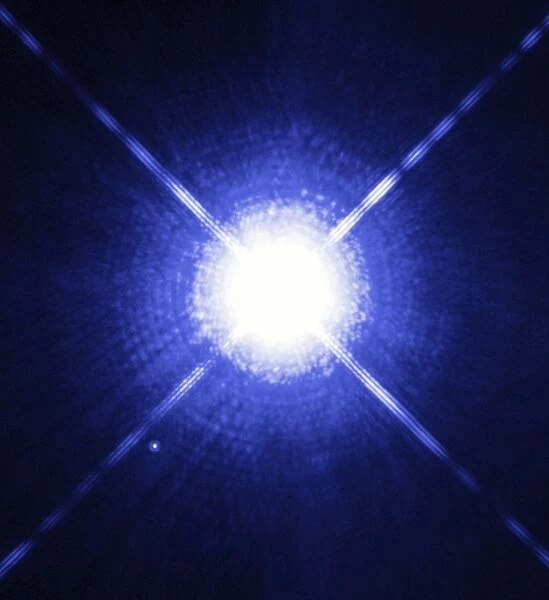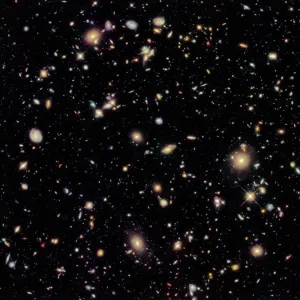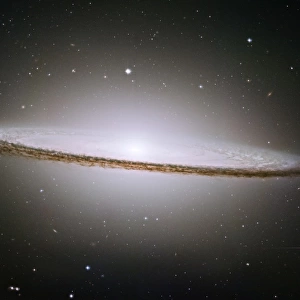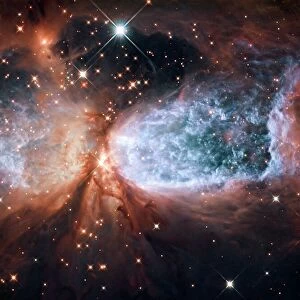Home > Science > Space Exploration > Hubble Telescope
Sirius binary star system
![]()

Wall Art and Photo Gifts from Science Photo Library
Sirius binary star system
Sirius binary star system, Hubble Space Telescope image. Sirius A (centre, Alpha Canis Majoris), in the constellation Canis Major, is the brightest star in the night sky and only 8.6 light years from Earth. It has a very small, faint companion, Sirius B (small dot at lower left). Sirius B, only 12, 000 kilometres in diameter, is a white dwarf star, the collapsed core of a star. Normally, the companion star would be obscured by the brightness of its companion, but Hubbles Wide Field Planetary Camera 2 instrument was used to locate the star, and other instruments were then used to measure the gravitational redshift of its light, and hence its mass. Sirius B has a mass 98% of that of our Sun. The results were published in December 2005
Science Photo Library features Science and Medical images including photos and illustrations
Media ID 6442813
© H. E. BOND/E. NELAN/M. BARSTOW/M. BURLEIGH/J. B. HOLBERG/NASA/ESA/STScI/SCIENCE PHOTO LIBRARY
Binary Star Canis Major Circle Circular Collapsed Dense Double Hubble Space Telescope Milky Way Optical Patterns Round Sirius Star Stellar Wfpc2 White Dwarf
FEATURES IN THESE COLLECTIONS
> Science
> Space Exploration
> Hubble Telescope
> Science
> Space Exploration
> Milky Way
> Science
> Space Exploration
> Telescopes Optical
EDITORS COMMENTS
This print showcases the mesmerizing Sirius binary star system, captured by the remarkable Hubble Space Telescope. At the heart of this celestial masterpiece lies Sirius A, also known as Alpha Canis Majoris, radiating its brilliance as the brightest star in our night sky. Remarkably, it resides a mere 8.6 light years away from Earth. Intriguingly nestled beside Sirius A is its diminutive companion, Sirius B. This faint and minuscule white dwarf star measures a mere 12,000 kilometers in diameter – a stark contrast to its luminous counterpart. Typically obscured by the overwhelming brightness of Sirius A, scientists utilized Hubble's Wide Field Planetary Camera 2 instrument to locate and study this elusive stellar partner. The groundbreaking discovery came through measuring the gravitational redshift of light emitted by Sirius B and subsequently determining its mass – an astonishing revelation that unveiled it possesses approximately 98% of our Sun's mass. Published in December 2005, these findings shed new light on binary stars while showcasing the immense capabilities of both Hubble and scientific exploration beyond our planet's boundaries. This awe-inspiring image serves as a testament to humanity's insatiable curiosity about the cosmos and reminds us of how much more there is yet to uncover within our vast universe.
MADE IN AUSTRALIA
Safe Shipping with 30 Day Money Back Guarantee
FREE PERSONALISATION*
We are proud to offer a range of customisation features including Personalised Captions, Color Filters and Picture Zoom Tools
SECURE PAYMENTS
We happily accept a wide range of payment options so you can pay for the things you need in the way that is most convenient for you
* Options may vary by product and licensing agreement. Zoomed Pictures can be adjusted in the Cart.




